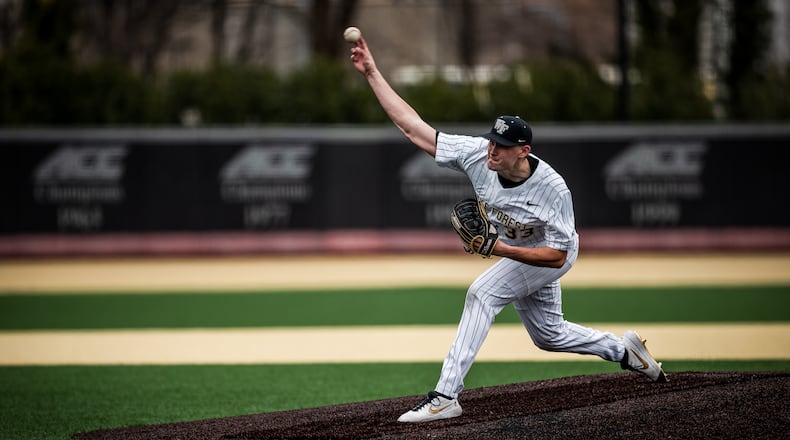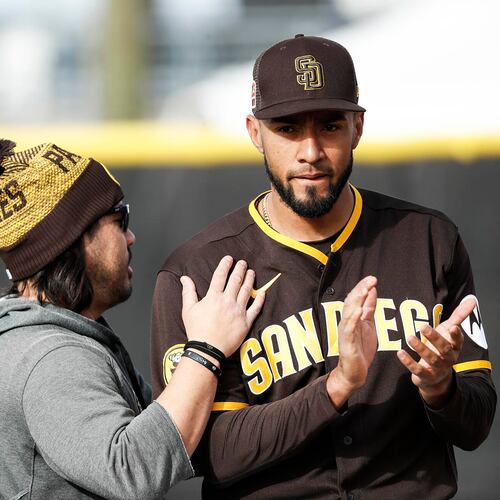Ryan Cusick’s path to the Braves was once powered by late-night PB&Js and chocolate milk.
Cusick wasn’t always the flamethrower he is today. His fastball floated in the mid-80s before it ascended to the low-90s earlier in his collegiate career at Wake Forest. Cusick now tops at 102 mph thanks to his resolve.
The Braves selected Cusick in the first round (No. 24 overall) of the 2021 draft. The 6-foot-6, 235-pound righty made six starts for Low-A Augusta afterward, posting a 2.76 ERA with 34 strikeouts in 16 ⅓ innings. He looked the part of a first-rounder, perhaps one who should’ve been selected sooner.
“He’s as good as anybody I’ve scouted, makeup-wise, in my 21 years,” said longtime Braves area scout Billy Best. “I’d bet some money on this one.”
Best scouted Cusick when he was a rail-thin, lanky high schooler. He spent his first three years at Lincoln-Sudbury Regional High School in his native Massachusetts before pitching at Avon Old Farms School in Connecticut his senior season. During his final two years, Wake Forest pitching coach Matt Hobbs was among the individuals encouraging Cusick to add strength. Cusick attacked the task with an unconventional idea.
Cusick set an alarm about 3 a.m. each day to scarf down a peanut butter and jelly sandwich and glass of chocolate milk. Not exactly the TB12 method.
“Looking back on it, probably not the healthiest thing because I needed my sleep then,” Cusick said. “But I think it got me to where I am. We look back and laugh. … I think my coaches thought I was a little crazy. And they’re probably right. I have a few screws loose.”
The PB&J story contextualizes Cusick. “You put something in front of him and he takes it to the extreme,” Hobbs said. “He was really skinny, awkward with his body and how he moved, but good arm. … He put on an unbelievable amount of weight in a decent amount of time. When he told me what he was doing, I said, ‘You’re crazy.’ But it was working. Suddenly, summer going into his senior year, things started changing for him significantly. We thought for a little while we were going to lose him in the draft because he was throwing so much harder.”
The Reds drafted Cusick in the 40th round in 2018, but he honored his commitment to Wake Forest. The Demon Deacons hired John Hendricks as pitching coach during Cusick’s freshman year after Hobbs left for Arkansas. Hendricks, a Wake Forest alum and former Mets scout, was already familiar with Cusick.
“He's as good as anybody I've scouted, makeup-wise, in my 21 years. I'd bet some money on this one."
Hendricks first scouted Cusick before his senior year of high school. The next time he saw him was fall semester of his freshman year. Hendricks was “enamored” with the increasingly electric arm; two months later, he became Cusick’s coach during winter break.
“After his first bullpen (session), I got up in his face the best I can – he’s a half-foot taller than me – and thumped him on the chest,” Hendricks said. “‘You’re going to be one of the greatest pitchers to pitch at Wake Forest. And I’m going to help push you and find that direction.’”
Hendricks had a mantra: Velocity isn’t a program, it’s a lifestyle. Cusick, described as calculated, meticulous and analytical, took that to heart. He and Hendricks scripted a detailed schedule down to each hour.
“It was the first time I’d gone to that level to build a pitcher’s plan because I realized that was how his brain works,” Hendricks said. “I had no idea how absolutely laser focused he was on developing himself. It was the level of intelligence. We spoke the same language right away, whereas most 19-year-olds, you’re having to teach them how to be men. He was already there.
“I’ve scouted and coached my whole professional life, over 20 years. I’ve worked with dozens of guys who pitched in the big leagues. He stands far out on his own with the total package of makeup, desire, focus. Nothing rattles him. It’s hard to explain to scouting departments how special of a makeup guy you’re getting because they’ve heard it a million times. But with Ryan, he’s literally in his own league. It’s different from anybody else I’ve ever worked with.”
Cusick credits time spent around minor leaguers and high-level college players during his earlier years for understanding the importance of discipline, nutrition and recovery. He’s developed a routine over eight years, one he supplements with new elements each offseason to continue his maturation as an athlete.
His final collegiate season, Cusick posted a 4.24 ERA with 108 strikeouts over 12 games (70 innings) as the Friday starter and co-captain.
“You talk about dedication, work ethic and single-minded pursuit of excellence,” Wake Forest coach Tom Walter said. “(Cusick’s) been one of the most impressive players I’ve coached in my time as far as his commitment to being the best pitcher he can be. … By the time he left, the transformation he made, not only physically but also his maturity. He worked hard at all phases of his baseball, academic and personal life.”
Hendricks worked under Braves general manager Alex Anthopoulos and scouting director Dana Brown in Toronto and considers both men mentors. The connection paid off: The Braves took Wake Forest southpaw Jared Shuster in the 2020 first round. Hendricks told Brown he’d be back for Cusick. “You’ve got to fish where the fish are,” Brown said after drafting Cusick at No. 24, one slot better than Shuster in the previous draft.
Best, who scouts the Carolinas, wasn’t sure Cusick would make it to the Braves’ pick. He remembers seeing the pitcher at his best April 16, 2021, when he fanned 11 over seven scoreless innings against Duke. Cusick reminded Best of a future Hall of Famer he evaluated two decades ago.
“He would show you signs of (Justin) Verlander with the durability, fastball and breaking ball,” Best said. “That might be too high expectations, but that’s who he showed glimpses of. You can look at his fastball, the curveball, both were pretty identical to Verlander. Time will tell.”
Under Hendricks’ tutelage, Cusick implemented a slider into his repertoire. The pitch impressed the Braves before Cusick reported to Augusta. In fact, the team encouraged Cusick to ditch his curveball and focus on the slider.
“I made so much more progress in 16 ⅓ innings than I would’ve had I continued to use the curveball,” he said. “I was really happy they let me go out there, get some innings under my belt and see my progress with the breaking ball. It was a confidence boost going into next year.”
Cusick expects the curveball back in his arsenal eventually, but he’s currently using a three-pitch mix, including a developing change-up he’s eager to see against batters. An effective change-up would perfectly complement the budding fastball-slider combo.
The Braves also helped Cusick simplify his approach and delivery, which trimmed his walks. He issued 4.5 walks per nine innings in college. He issued just four walks in 16 ⅓ innings at Augusta. Cusick’s command will be the storyline across the upcoming campaign.
“The one thing people knocked him on in college was walking people, and he goes out in pro ball, stops walking people,” Hobbs said. “He’s like the Terminator when it’s time to go to work every day. … He’s really good because of how hard he worked to get there, not because of a God-given ability that he didn’t do anything to earn. He’s turned himself into this.”
After spending the offseason in Winston-Salem, Cusick reported to spring training Feb. 25. If history is any indication, this season will be his greatest leap yet – and it won’t even require forcing down PB&Js.
About the Author
Keep Reading
The Latest
Featured


